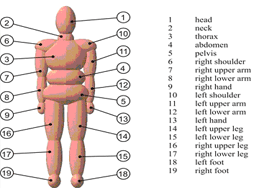More information
Main author
Krašna, S.
Co-Authors
Ambrož, M.; Prebil, I.; Ravnik, D.; Hribernik, M.
Type of media
Publication type
Lecture
Publication year
2005
Publisher
14. EVU-Jahrestagung, Bratislava 2005
Citation
-

Human body segmentation
English, 14 pages, 15 figures, 20 references
Keywords: body motion, modelling, joint properties
A procedure for estimation of passive joint properties is introduced. Human body is modeled as a multibody dynamical system with spherical and revolute joints connecting the body segments, which are regarded as rigid bodies. A comparison of the model response with sled test results shows an influence joint stiffness and damping properties on occupant body response in a traffic accident situation. Therefore their correct estimation is essential for determining the possible injuries arising from the accident. The joint resistive properties are defined as design variables in a non-linear mathematical programming problem. Using suitable optimisation methods, the difference between the occupant model response and the occupant experimental response can be minimised over the design variable definition range, thus estimating the joint characteristics. Geometrical and inertia properties of the occupant body segments are estimated using medical imaging techniques.